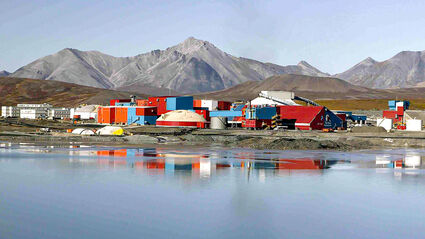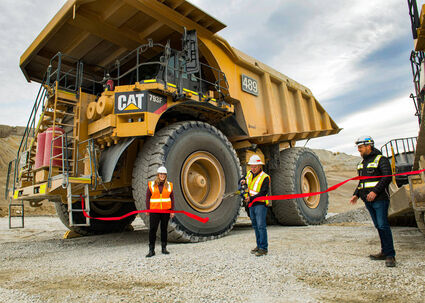Mining lifts Alaska economy during COVID
Minerals industry injects $2 billion into Alaska during 2020 North of 60 Mining News – February 26, 2021
Last updated 3/25/2021 at 4:03pm

NANA Corp.
With robust paychecks to 630 workers, payments to NANA, and fees paid to AIDEA, the economic benefits from the Red Dog zinc mine in Northwest Alaska are felt across the state.
Mining and mineral exploration helped to bolster an Alaskan economy plagued by COVID-19 during 2020.
According to a report prepared by the McKinley Research Group, a renowned Alaska-based research and consulting firm formerly known as McDowell Group, Alaska's mining industry injected roughly $2 billion into the Alaska economy last year.
Commissioned by the Alaska Miners Association and Council of Alaska Producers, "The economic benefits of Alaska's mining industry" report found that the mining sector paid high wages to Alaskans living in more than 90 communities across the state, purchased goods and services from Alaskan business, flowed cash into Alaska Native corporations, and paid into state and local government coffers during the pandemic.
"As a critical industry, our producing mines and projects implemented strict COVID-19 protocols to protect their workers and contractors, and keep community members safe. As a result, there were no significant production disruptions or worker layoffs; millions of dollars in payroll continued to be infused throughout many Alaska communities," Alaska Miners Association penned in a statement announcing the release of the 2020 mining industry economic report.
U.S. Geological Survey calculates that Alaska mines produced roughly $3.2 billion worth of gold, silver, zinc, lead, sand, gravel, and rock during 2020. This does not account for the more than 800,000 tons of coal dug up at Usibelli Coal Mine operations near Healy and shipped to Interior Alaska heat and power plants.
The roughly $2 billion of precious and base metals shipped out of Alaska last year accounted for approximately 38% of the state's exports, based on 2019 export numbers.
Healthy paychecks
Alaska mining sector's single largest contribution to the state's economy is delivered via the healthy paychecks brought home by workers living in more than 90 villages, towns, and cities across The Great Land.
Alaskan mines, development and mineral exploration projects paid roughly $542 million in wages to some 4,700 workers. This works out to be an average wage of $115,320 per year for people working directly in the sector, more than twice the $56,985 average wage across all Alaska industries last year.
When you add in the indirect jobs, or workers who provide services to the mining companies but are not directly employed by them, the number of jobs jumps to 9,600 and the payroll totals $890 million.
Compared to 2019, this comes to 200 more total jobs and $150 million in additional wages during a year when Alaskans needed a boost.
"There were no significant production disruptions or worker layoffs; millions of dollars in payroll continued to be infused throughout many Alaska communities," according to the report.
Keeping mining operations running safely through the pandemic also helped inject critical cash into Alaska's hospitality sector, which was hit hard by travel restrictions and lockdowns that left hotel beds and restaurant tables empty during 2020.
Mining and mineral exploration projects in Alaska utilized facilities in Juneau, Fairbanks, and Anchorage to quarantine workers en route to their shifts in remote camps across the state.
All told, it is estimated that Alaska mining projects spent roughly $880 million purchasing goods and services from Alaska vendors last year.
ANCSA payments
While six-figure paychecks and doing business with Alaskans were by far mining's largest contributions to the state's economy last year, the industry's payments to Alaska Native corporations had a wider reach, in terms of geography and populace.
According to data collected by McKinley Research, Alaska Native Claims Settlement Act corporations received $175 million from mining during 2020.
NANA Corp., the ANCSA regional corporation for Northwest Alaska, was the recipient of $173.5 million of these funds due to the net proceeds from zinc and other metals recovered from the Red Dog Mine on its lands.
Most of this money paid to NANA, however, does not stay in Northwest Alaska but is distributed to every corner of the state, due to the Section 7(i) and 7(j) provision of ANCSA.
Section 7(i) requires regional corporations to distribute 70% of net revenues from resource development on ANCSA lands among all 12 regional corporations. In turn, Section 7(j) requires that half of the 7(i) payments to be distributed to the respective village corporations within each of the ANCSA regions.
This means that $104.1 million of NANA's 2020 proceeds from Red Dog were distributed to the other 11 ANCSA Regional corporations, half of which made its way to more than 200 villages across Alaska.
The "leveling effect" of sections 7(i) and 7(j) creates economic activity that otherwise would not occur in recipient regions and provides village corporations with vital funding.
In total, NANA has received approximately $2.3 billion in proceeds from Red Dog since the start of mining at this world-class zinc deposit, of which about $1.5 billion in 7(i) payments has been distributed to the other ANCSA corporations.
Donlin, a 39-million-ounce gold mine project on Native land in the Calista Corp. region, is expected to be a second major mining contributor to ANCSA corporations once production is reached at this near-development project in Southwest Alaska.
Government coffers
Mining companies are also a significant source of state government revenue and a major financial contributor to local governments across the state.
During 2020 Alaska paid nearly $117 million into state coffers. This includes:
• $62.1 million in mining licenses, taxes, rents, and royalties.
• $28.4 million to the Alaska Industrial Development and Export Authority for the use of state-owned facilities such as the DeLong Mountain Regional Transportation System for delivering metal concentrates from the Red Dog Mine, and Skagway Ore Terminal in Southeast Alaska.
• $15.2 million to the Alaska Railroad Corporation for moving coal, sand, and gravel.
• $11 million in mining lease, royalty, and construction material sales from Alaska Mental Health Trust lands.
• $9.7 million in other fees such as income from material sales, and payments made for the large mine permit coordination program.
While less than what is paid to the state, the nearly $49 million paid to local governments last year is much more impactful.
In addition to the payments made to NANA, the Red Dog Mine is the sole "taxpayer" in the Northwest Arctic Borough, a municipality that blankets the same 40,750 square miles of Northwest Alaska.
Red Dog, which is operated by Teck Resources Ltd., contributed $26.2 million in payment in lieu of taxes to the borough during 2020.
In addition to the PILT payment, Red Dog contributed $8 million to the Village Improvement Fund. Administered by the borough, with input from the 11 villages it encompasses, this fund is earmarked for community programs, services, and infrastructure.

Kinross Gold Corp.
With Fairbanks Chamber of Commerce President Marisa Sharrah (left) and Fort Knox General Manager Jeremy Brans (right) looking on, Fort Knox Projects Manager Jason Perino cuts the ribbon on a project that extends the life of Kinross Gold's Fort Knox Mine, a major employer and the largest taxpayer in the Fairbanks North Star Borough.
In Interior Alaska, Kinross Gold Corp.'s Fort Knox Mine paid $11.1 million in property taxes to the Fairbanks North Star Borough. This makes the gold operation the single largest taxpayer in the borough.
Mining operations are also the biggest source of taxes for the City and Borough of Juneau in Southeast Alaska.
The largest Juneau taxpayer is Hecla Mining Company's Greens Creek silver mine, which paid $1.9 million to the borough last year.
This was followed closely by the $1.4 million paid to the borough by Coeur Mining Inc.'s Kensington gold mine, the second largest Juneau taxpayer.
Together, the roughly $2 billion mining introduced into local and state governments, ANCSA corporations, businesses across the state, and healthy paychecks helped support Alaskan families and communities during the COVID-19 pandemic.
With even higher levels of activity at mineral exploration projects and mines this cash infusion is expected to reach new heights during 2021.


















Reader Comments(0)